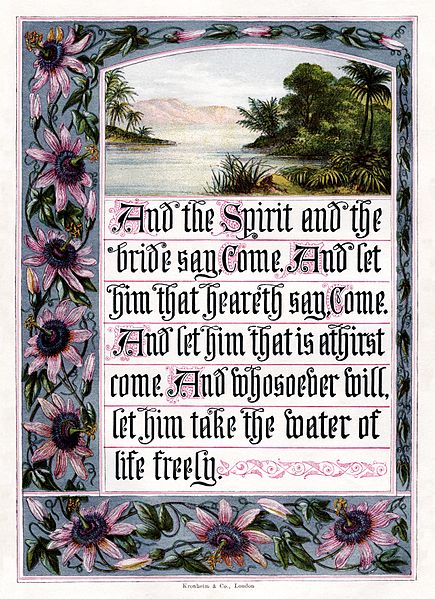.
Agama sinaita, Jordan: photo by Ester Inbar, 2010
The 'visual room' is the one that has no owner.
Milky Way arching across panorama of Southern Sky above the Paranal platform of European Southern Observatory's Very Large Telescope (moon rising, zodiacal light shining above it, Milky Way stretching across sky; visible to right and below the arc, Small and Large Magellanic Clouds): photo by ESO/H.H. Heyer, 2001; image by Maedin, 2010
I can as little own it as I can walk about it, or look at it, or point to it.
Eumeces fasciatus (Five-lined Skink), having lost part of its tail: photo by Thegreenj, 2007
Inasmuch as it cannot be any one else's it is not mine either.
Bradypus variegatus (Three-toed Sloth), feeding, Cahuita National Park, Costa Rica: photo by Mehlführer, 2007
In other words, it does not belong to me because I want to use the same form of expression about it as about the material room in which I sit.
Revelation 22: 17 (King James Version): Baxter process illustration by Joseph Martin Kronheim, from The Sunday at Home: A Family Magazine for Sabbath Reading, London, 1880; image by Adam Cuerden, 2010
The description of the latter need not mention an owner, in fact it need not have any owner.
But then the visual room cannot have any owner. "For" -- one might say -- "it has no master, outside or in."
Earth cloud cover, 11 July 2005: Moderate Resolution Imaging Spectroradiometer (MODIS) image by Marit Jentoft-Nilsen, 2005 (NASA Earth Observatory)
One might also say: Surely the owner of the visual room would have to be the same kind of thing as it is; but he is not to be found in it, and there is no outside.
Bolshevism without a Mask, propaganda poster from Anti-Bolshevik exhibition of the NSDAP Gauleiter, Reichstag Building, Berlin, 6 November-19 December 1937: photo by Herbert Agricola, 1937 (Library of Congress)
The 'visual room' seems like a discovery, but what its discoverer really found was a new way of speaking, a new comparison; it might even be called a new sensation.
Highway 401, busiest highway in North America, closed 10 August 2008 during Toronto pipeline explosion: photo by Kenny Louie, 2008
Ludwig Wittgenstein: from Philosophical Investigations, 1945, published 1953, trans. G.E.M. Anscombe









Tom, ohne, that would be "Bolshevism without a mask" (Bolshevism unmasked? I'm not sure), wouldn't it? That whip is dreadfully scary, much more so than a gun.
ReplyDeletePhilosophers and poets are sister-brothers, certainly.
ReplyDeleteI love the way you illustrate/counterpoint these texts.
I dare say this post has an emblematic configuration.
ReplyDelete¡Muy bueno, me encantó!
In Norwegian, rom (pronounced, roughly, "room") means "space" (both "a space" and "outer space").
ReplyDeleteThanks, AJP.
ReplyDeleteAbout that (now corrected) attribution, ancient pseudo-sages, readily owning up to encroaching blindness, owe much to the keener eyes of younger and more alert non-owners of the visual room.
Scary, that whip, yes, it definitely prints on the visual imagination.
About "room"/"rom"/"space" -- in Wittgenstein's original the term introduced is "das 'visuelle Zimmer'".
This is your area of expertise.
He could have used Raum==room, space, place, area, expanse, capacity, volume. Instead, Zimmer==room, apartment, chamber, would be more specifically architectural, in a house, as opposed to space outside.
English makes the one term do double duty, here.
John,
Thanks very much. It's been the obscure obsession of the past couple of years to attempt to tune into the correspondences and conversations between images and words. Perhaps the obsession began in a distrust of words. Not that images are in fact any easier to trust, but they appear to want to keep the conversations open, or at least to lend to that happening.
"But then the visual room cannot have any owner. 'For' -- one might say -- 'it has no master, outside or in.'"
"Inasmuch as it cannot be any one else's it is not mine either."
Julia,
I think the Paradisal citrus, the framed passage from Revelation, the Anti-Bolshevik propaganda poster and the closed superhighway were the original emblems. But images that seem to try to "own" their meanings can be tricked by context, perhaps, into signifying in other ways.
"One might also say: Surely the owner of the visual room would have to be the same kind of thing as it is; but he is not to be found in it, and there is no outside."
In any event the original emblematic/Apocalyptic subtext has been to some extent buried over in the visual room as it now emerges.
The images perhaps begin to "say" something they had not originally been intended to say; because, of course, anybody's intentions, like anybody's claim to ownership, in this area of images, should probably always be seen as at best partial.
"The 'visual room' seems like a discovery, but what its discoverer really found was a new way of speaking, a new comparison; it might even be called a new sensation."
By the way, speaking of debts, an apology is owed that beautiful Jordanian Agama sinaita for having part of its extremely expressive face unconscionably cropped away. A click will restore it.
ReplyDeleteI once long ago knew a person who said he could never figure out what Wittgenstein was trying to say.
The Red Sea Agama turns bright blue when there is a striking female about. The female breaks out in red spots at such moments.
Was something like this, maybe, what Wittgenstein was really "trying to say"?
As this seems to be the Day of the Agama... when you check out the amateur footage, the Agamas turn out to be pretty cool customers.
I can think of plenty of things worse that what appears to be the life of a Tanzanian Agamid.
Your blue days are your happy ones. As Marvin Gaye once sang, It can't ever be wrong.
And finally... to be selected as emblematic models. To come clean re. Julia's suggestion, it is certainly true that the Agama, the Skink and the Sloth were such. To have five lines, three toes and the ability to turn blue at the drop of wink... the wink alone would be a convincing scale.
ReplyDeleteTrue, but your whole post is kind of emblematic... The perfect conection between image & text.
ReplyDeleteRepresenting and interpreting each other at the same time: an usual definition of the baroque emblem genre
(Perdón no puedo explicarme bien en inglés!)
Yo entiendo perfectamente, usted lo ha dicho mejor que yo podría tener.
ReplyDelete(También me has salvado de las contorsiones de la falsa modestia!)
I hadn't ever thought about "room" having both meanings: "Do you have enough room?", as well as bedroom. You're right, das visuelle Zimmer is very specific. In architecture, a place is a defined piece of space. During Wittgenstein's lifetime architecture was (both for better and worse) more concerned with infinite space than it was with place.
ReplyDeleteAnd I love the way the texts go up against the pictures. Great pictures and great texts, always.
Tom,
ReplyDeleteMany thanks for LW's thoughts here, on the visual (and material) room ---
6.26
grey whiteness of fog against invisible
ridge, song sparrow calling from branch
in foreground, wave sounding in channel
paint scene evident in frame
of mind, seems to be one
measured against the horizon,
what is, and the “facts”
grey-white of fog reflected in channel,
pale blue sky on horizon next to point
The text, and especially the photographs, sustained me during a fairly difficult day where everything else was irritating to the point of being maddening. It's hard to know what to say about or to the three-toed sloth other than "hi, you're quite something".
ReplyDelete"It's been the obscure obsession of the past couple of years to attempt to tune into the correspondences and conversations between images and words."
ReplyDeleteWhen intent and result dovetail, this is art. Thanks. This is very powerful, very resonant.
Stephen, Curtis, Don, many thanks.
ReplyDeleteAJP, thinking further about the difference between the two kinds of "room" (in German) has been interesting, particularly "in light of" the way the back-lit visual room or chamber in which we view these internet images seems to have a special magic lantern or illuminated cabinet aspect.
I envy your skills in designing and building "real" rooms and spaces, and suppose this would be my (extremely) modest virtual equivalent.
Tom,
ReplyDeleteNone of us own anything, in the end. Yesterday I went to Carmel to scatter my father's ashes -- some near the rock in the watershed he he hiked to every day, others (paddling out on my board) in Pacific below where he lived . . . .
6.27
silver edge of sun rising over shadowed
ridge, song sparrow calling from branch
in foreground, wave sounding in channel
instead of extending in fact,
accidents of perception
sound in this, of particular
passing that, “accident”
grey-white clouds reflected in channel,
wingspan of gull flapping toward point
accidents of perception
ReplyDeletesound in this, of particular
passing that, “accident”
Stephen,
What a moving way to commemorate your father's passing, and for that matter the passing of all things (much on the mind here too, stuck indoors, of late).
Keep on paddling out...
"the world is all that is the case" "there are no ideas but in things"
ReplyDelete~ the word is all that in lower case, there are no ideas but instinct
"Songs of innocence and experience"
~ songs of exigence and the inner ear
"The visual room" ~ the visceral rheum, the marsupial vis-a-roo, a pouch, letters sent between what is seen and what is just a red wheelbarrow...
nice Tom, thanks, bouncing all over the place!